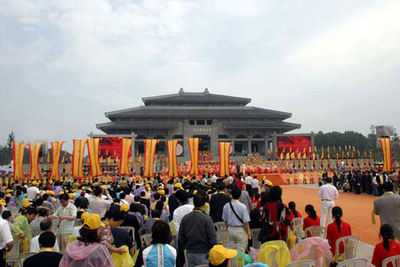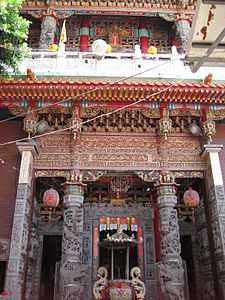Shennong
_derivative.jpg)
Shennong (Shen-nung; simplified Chinese: 神农; traditional Chinese: 神農; pinyin: Shénnóng; Wade–Giles: Shen2-nung2; Japanese: Shin'nō, 神農; Korean: 신농, Sinnong; Vietnamese: Thần Nông), whose name literally means "Divine Farmer" and who is also known as the Emperor of the Five Grains (t 五穀先帝, s 五谷先帝, p Wǔgǔxiāndì), was a legendary ruler of China and culture hero. Shennong is considered to have been one of the Three Sovereigns (also known as "Three Emperors") who lived some 5,000 years ago. Shennong has been thought to have taught the ancient Chinese not only their practices of agriculture, but also the use of herbal drugs.[1] Shennong is among the group of variously named heroic persons and deities who have been traditionally given credit for various inventions: these include the hoe, plow (both leisi style and the plowshare), axe, digging wells, agricultural irrigation, preserving stored seeds by using boiled horse urine, the weekly farmers market, the Chinese calendar (especially the division into the 24 jieqi or solar terms), and to have refined the therapeutic understanding of taking pulse measurements, acupuncture, and moxibustion, and to have instituted the harvest thanksgiving ceremony (Zhaji Sacrificial Rite, later known as the Laji Rite).[2]
"Shennong" can also be taken to refer to his people, the Shennong-shi (t 神農氏, s 神农氏, p Shénnóngshì) or "Clan of Shinong". Since shì can mean both "clan" and "maiden name" and serve as a masculine honorific like "mister" or "sir", it is sometimes used in reference to his people, sometimes in reference to the individual.[citation needed]
Mythology

In Chinese mythology Shennong, besides having taught humans the use of the plow together with other aspects of basic agriculture, the use of medicinal plants, and having been a god of the burning wind (perhaps in some relationship to the Yan Emperor mythos and/or slash-and-burn agriculture,[3] in which the ash produced by fire fertilizes the fields), was sometimes said to be a progenitor to, or to have had appointed as one of his ministers, Chi You; and like him, they were both ox-headed, sharp-horned, bronze-foreheaded, and iron-skulled.[4] One difference between mythology and science is exemplified in Chinese mythology: Shennong and Huangdi (often known as "the Yellow Emperor") were supposedly friends and fellow scholars, despite the 500 years or seventeen or eighteen generations between the first Shennong and Huangdi; and, that together they shared the alchemical secrets of medicine, immortality, and making gold.[5]
According to the eighth century CE historian Sima Zhen's commentary to the second century BCE Shiji (or, Records of the Grand Historian), Shennong is a kinsman of the Yellow Emperor and is said to be an ancestor, or a patriarch, of the ancient forebears of the Chinese. The Han Chinese regarded them both as their joint ancestors.
Popular religion
According to some versions of the myths about Shennong, he eventually died as a result of his researches into the properties of plants by experimenting upon his own body, after, in one of his tests, he ate the yellow flower of a weed that caused his intestines to rupture before he had time to swallow his antidotal tea: having thus given his life for humanity, he has since received special honor though his worship as the Medicine King.[6] The sacrifice of cows or oxen to Shennong in his various manifestations is never at all appropriate, instead pigs and sheep are acceptable. Fireworks and incense may also be used, especially at the appearance of his statue on his birthday, lunar April 26, according to popular tradition. Under his various names, Shennong is the patron deity especially of farmers, rice traders, and practitioners of Traditional Chinese Medicine. Many temples and other places dedicated to his commemoration exist.[7]
Historicity
Shennong cannot be said to be a completely historical figure. However, Shennong, individual and clan, are very important, in the history of culture—especially in regards to mythology and popular culture. Indeed, Shennong figures extensively in historical literature.
Shennong in literature
Sima Qian mentions that the rulers directly preceding the Yellow Emperor were of the house (or societal group) of Shennong.[8] Sima Zhen, who added a prologue for the Shiji, said his surname was Jiang (姜), and proceeded to list his successors. An older and more famous reference is in the Huainanzi; it tells how, prior to Shennong, people were sickly, wanting, starved and diseased; but he then taught them agriculture, which he himself had researched, eating hundreds of plants — and even consuming seventy poisons in one day.[9] Shennong also features in the book popularly known in English as I Ching. Here, he is referenced as coming to power after the end of the house (or reign) of Paoxi (Fu Xi), also inventing a bent-wood plow, a cut-wood rake, teaching these skills to others, and establishing a noonday market.[10] Another reference is in the Lüshi Chunqiu, mentioning some violence with regard to the rise of the Shennong house, and that their power lasted seventeen generations.[11]
The various subsequent notices of Shennong include Anthony Christie's Chinese Mythology, which references Shennong (as Shen-nung) six times, three times with pictures, according to the 1968 index.[12]
The Shénnóng Běn Cǎo Jīng is a book on agriculture and medicinal plants, attributed to Shennong. Researcher suggests that it is a compilation of oral traditions, written between about 300 BCE and 200 CE.
More recently, the 2013 novel Dream of the Yellow Dragon by Andy Sedlak popularized the character Shen Nong for a western audience. In the novel an American owner of an organic flower shop accidentally meets the Chinese god of agriculture and medicine while having breakfast in Beijing. The god has been in exile since the start of the green revolution. The story revolves around these characters attempt to return the god to glory and return agriculture to the common people.[13]
Popular culture

As noted above, Shennong is said in the Huainanzi to have tasted hundreds of herbs to test their medical value. The most well-known work attributed to Shennong is The Divine Farmer's Herb-Root Classic (simplified Chinese: 神农本草经; traditional Chinese: 神農本草經; pinyin: Shénnóng Běncǎo Jīng; Wade–Giles: Shen2-nung2 Pen3-ts'ao3 Ching1), first compiled some time during the end of the Western Han Dynasty — several thousand years after Shennong might have existed. This work lists the various medicinal herbs, such as lingzhi, that were discovered by Shennong and given grade and rarity ratings. It is considered to be the earliest Chinese pharmacopoeia, and includes 365 medicines derived from minerals, plants, and animals. Shennong is credited with identifying hundreds of medical (and poisonous) herbs by personally testing their properties, which was crucial to the development of Traditional Chinese medicine. Legend holds that Shennong had a transparent body, and thus could see the effects of different plants and herbs on himself. Tea, which acts as an antidote against the poisonous effects of some seventy herbs, is also said to have been his discovery. Shennong first tasted it, traditionally in ca. 2737 BC, from tea leaves on burning tea twigs, after they were carried up from the fire by the hot air, landing in his cauldron of boiling water.[14] Shennong is venerated as the Father of Chinese medicine. He is also believed to have introduced the technique of acupuncture.
Shennong is said to have played a part in the creation of the guqin, together with Fuxi and the Yellow Emperor. Scholarly works mention that the paternal family of famous Song Dynasty General Yue Fei traced their origins back to Shennong.[15]
Places
Shennong is associated with certain geographic localities including Shennongjia, in Hubei, where the rattan ladder which he used to climb the local mountain range is supposed to have transformed into a vast forest. The Shennong Stream flows from here into the Yangtze River.
Gallery
-

Shennongding: "Shennong's peak", associated with the story that Shennong had a ladder which he used to climb up and down the mountain, and which later turned into the local forest.
-

A picture of Shennong bencao jing (Shennong's Root and Herbal Classic): a classic work on plants and their uses, named in attribution to Shennong.
-

Shennong tasting plants to test their qualities upon himself.
-
The Shennongxi Bridge near its confluence with the Yangtze River.
-

Shennong depicted in a more bovine and less humanistic version in a Goguryeo (ancient Korean) tomb mural.
Cite error: There are <ref> tags on this page, but the references will not show without a {{reflist}} template (see the help page).
See also
| Wikimedia Commons has media related to Shennong. |
- Descendants of Yan & Huang Emperors
- Shennong Stream
- Three Sovereigns and Five Emperors
- Yandi
- Yellow Emperor
Notes
- ↑ Christie, 87
- ↑ Yang, 190-199
- ↑ Christie, 90
- ↑ Christie, 90
- ↑ Christie, text caption 116 and picture of ivory statue 117
- ↑ Yang, 195
- ↑ Yang, 198-199
- ↑ Wu, 53, referring to Shiji, Chapter One.
- ↑ Wu, 45, referencing Huainanzi, xiuwu xun
- ↑ Wu, 54, referencing I Ching, xici, II, chapter 2
- ↑ Wu, 54, lisulan, 4, yongmin.
- ↑ Christie, 141
- ↑ http://ariessunpress.com/Books/Dream_of_the_Yellow_Dragon_by_Andy_Sedlak/book.php
- ↑ Jane Reynolds, Phil Gates, Gaden Robinson (1994). 365 Days of Nature and Discovery. New York: Harry N. Adams. p. 44. ISBN 0-8109-3876-6.
- ↑ Kaplan, Edward Harold (1970). Yueh Fei and the founding of the Southern Sung (PhD Thesis). University of Iowa. OCLC 63868015.
References
- Christie, Anthony (1968). Chinese Mythology. Feltham: Hamlyn Publishing. ISBN 0-600-00637-9.
- Forbes, Andrew ; Henley, David (2011). Shennong in: China's Ancient Tea Horse Road. Chiang Mai: Cognoscenti Books. ASIN: B005DQV7Q2
- Wu, K. C. (1982). The Chinese Heritage. New York: Crown Publishers. ISBN 0-517-54475-X.
- Yang, Lihui, et al. (2005). Handbook of Chinese Mythology. New York: Oxford University Press. ISBN 978-0-19-533263-6
External links
- Statue of Shennong in ZhuZhou
- Variants on the nóng character.
- "Shen Nong and Tea" article from The Tea Site.
| Shennong | ||
| Regnal titles | ||
|---|---|---|
| Preceded by Fuxi |
Emperor of China c. 2737 BC – c. 2698 BC |
Succeeded by Yellow Emperor |

